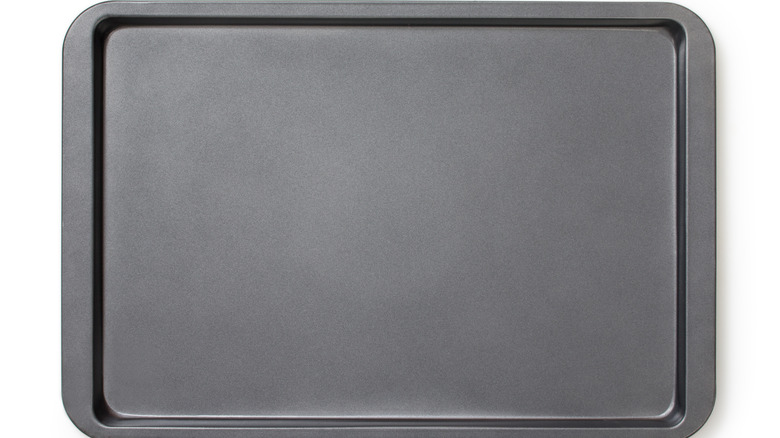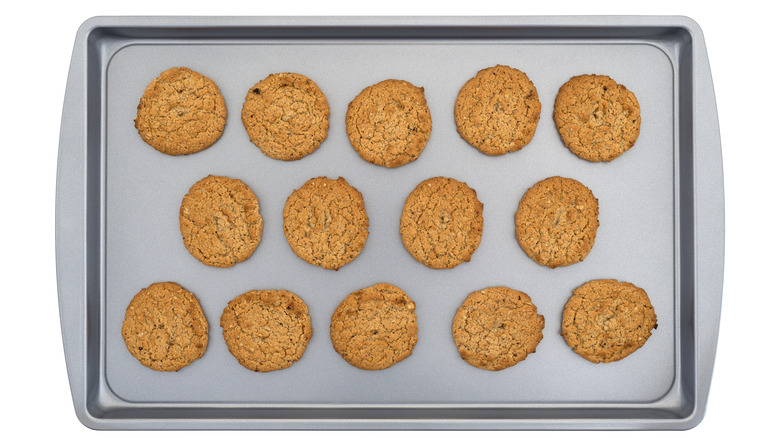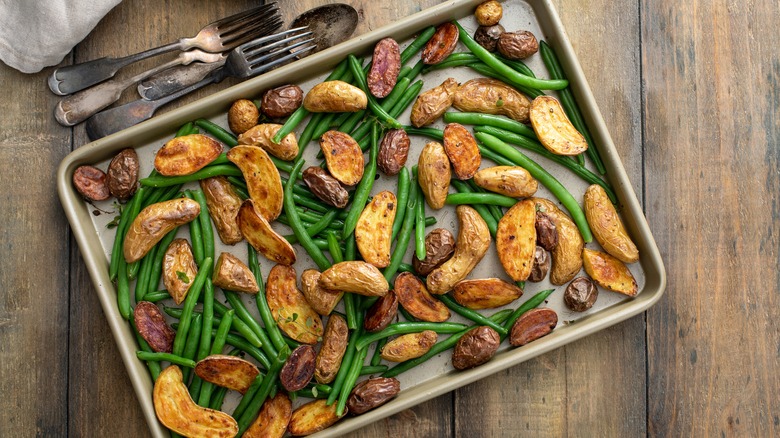The Good And The Bad Of Nonstick Sheet Pans
Sheet pans are a true kitchen workhorse. Roasting vegetables? Grab a sheet pan. Making cookies? Sheet pan. Baking salmon? You guessed it ... a sheet pan. These versatile pieces of cookware can even be used to bake multiple foods at once, creating what's known as a sheet pan dinner.
Now that we've established that you need this tool in your kitchen, how do you go about choosing one? Nonstick sheet pans are a great option and available in a wide range of sizes and materials, constructed using a conductive metal core and coated with either polytetrafluoroethylene (PTFE), colloquially known as Teflon, ceramic, or silicone. Standard sheet pans, also known as half-sheets, are around 18 inches wide,which works well in most cases, but if you're using a toaster oven, you may need to step down to the 14-inch-wide quarter-sheet. You also want to look for one that's sturdy enough for regular use, as thinner pans may warp over time.
Like every tool, sheet pans have their pros and cons, so what are they?
The advantages of nonstick sheet pans
Nonstick sheet pans are easy to use and well-suited for cooking a wide variety of dishes. One of the biggest advantages of nonstick sheet pans is right in the name — they're designed to prevent food from sticking. Everything from sheet cake to roasted pork loin should slide right off these pans with ease, whether hot or cold. This can help keep delicate foods whole, eliminating the risk of serving a tattered fish fillet or needing to glue a cake back together with frosting. The nonstick coating also means they're chemically non-reactive so acidic foods like roasted tomatoes or lemony chicken won't be affected, where they would for an aluminum sheet pan, for instance.
The nonstick properties of these pans can also help cut down on prep and cleaning time. With other pans, you may need to grease or line the pan with parchment paper before baking. When using a nonstick pan, batter or dough can go right onto the surface without any conditioning, and roasted vegetables will require far less oil. And when it's time to clean up, less stuck food means less scraping, and any bits that remained should wipe away easily.
For a little added fun, ceramic nonstick pans come in a variety of colors. Teflon and silicon-coated pans are pretty much all black or gray, but ceramic-coated pans are available in shades ranging from white to bright blue.
The disadvantages of nonstick sheet pans
The biggest downside to nonstick pans is that they are susceptible to wear and tear and need to be replaced more frequently than other types. Even a small scratch in the coating will compromise their nonstick properties, as food will cling to the uneven surface. Nonsticks aren't compatible with metal utensils, which can easily scrape the pan. No matter how careful you are, a nonstick coating will stain and eventually wear.
When used properly, nonstick pans are safe for home cooking. Health concerns were mainly linked to a chemical known as PFOA, which the industry has since replaced with PTFE. To use nonstick pans safely, never heat them above the recommended temperature (around 500 degrees Fahrenheit for Teflon, and around 430 degrees for silicon pans), and discard them once the coating becomes cracked or scratched. Damage to the coating not only reduces the pan's effectiveness but can leach chemicals into your food.
Pan coatings can also affect the cooking time of certain foods. Nonstick pans are generally darker and less reflective than their aluminum counterparts. During baking, shiny metal reflects heat, while darker colors absorb it. Because they retain more heat, dark pans can alter the cooking times of recipes and increase browning. If your recipe was written for an aluminum sheet pan, it might no longer be accurate.
Nonstick sheet pans require a little extra care, but if treated well, they can make cooking and cleaning easier.


